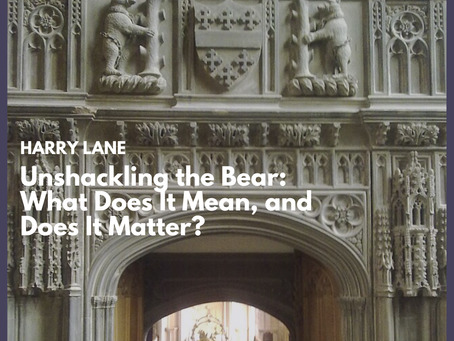top of page
rewind.
Search


The Nizari ‘Assassins’: Myth and Murder in the Twelfth-Century Near East
On the evening of Wednesday 6 September 1090, five years before the First Crusade was called, the Shi’a missionary Hasan-i Sabbah slipped unnoticed into the seemingly impregnable mountain fortress of Alamut. After peacefully converting the inhabitants of the Persian stronghold, and removing its Sunni master, he began to build a movement that would become shrouded in myth. The group that would come to be known as the ‘Assassins’ would play a significant role in the politics of
Harry McNeill
4 days ago8 min read


The Meiji Restoration: Japan’s Modern Miracle
In the period lasting from 1603 to 1868, Japan withheld itself from global interactions, opting instead for a Sakoku period of forced isolationism. Aside from a singular Dutch trading port on the island of Dejima, no foreign traders, missionaries or military personnel were allowed into or out of Japan. This however ended abruptly in 1853, where the modern military of the United States forced trading relations through their ‘gunboat diplomacy’ tactics. This directly led to the
Max Martin
5 days ago4 min read


Belief and the Environment: When Spirituality Defines Place
The largest of the three megalithic monuments, the King’s Men stone circle, is late Neolithic, circa 2,500BCE. Image: William Raven I had been reading the words of Edward Thomas’ ‘ In Pursuit of Spring’ and inspired by his journey, “on or with bicycle” down to the South-West from London, I, too, detoured on one of my trips down to visit my girlfriend, Lily, in Bristol. Thomas’s journey through “the Quantock Hills, to Nether Stowey, Kilve and West Bagborough” offers a “gli
Will Raven
6 days ago4 min read


From Public to Community: Lessons from the Community Arts Movement
‘Public history’ is a funny old term when you stop and think about it. People argue endlessly about what the historian’s role is supposed to be in this process – a guide, a guardian of knowledge, a storyteller, or something else entirely. But in all these debates, one question usually slips through the cracks: What is the ‘public’ actually meant to do in public history? And the moment you ask that; you uncover another assumption: why on earth are we separating the ‘publi
Jakob Reid
Dec 37 min read


Black Britain Before Windrush
On June 21st 1948, the Empire Windrush docked in the United Kingdom, bringing with it 492 immigrants from the Caribbean, encouraged to migrate to provide manual labour to restore post-war Britain. Marked as “the primary scene of Black migration to Britain,” and even posed by academics as the “single event in launching multicultural Britain” there is a generalisation that Black Culture before 1948 was non-existent and that Windrush launched British society into multiculturalis
Lorna Wells
Dec 24 min read


America’s Case for Conflict: Vietnam and the Collapse of Credibility
The Phantom Attack In the summer of 1964, the Gulf of Tonkin became the setting for one of the most consequential misunderstandings in modern American history. The destroyer USS Maddox was conducting intelligence patrols along the North Vietnamese coast when, on August 2nd, it exchanged fire with several Vietcong patrol boats. The incident was brief and inconclusive but quickly became framed as proof of North Vietnamese aggression. Two days later, reports of a second attack
Baptiste Laurencin
Nov 186 min read


Mary Wollstonecraft: Shedding Light on Feminism during the Enlightenment
The Enlightenment is often viewed as a period of rationalised thinking, that sought to emphasise individualism and challenge the traditional authority. Those who promoted these ideals are often regarded as the ‘great Enlightenment thinkers’, and if I were to ask you to name me these people, you might suggest John Locke, father of liberalism; Voltaire, criticiser of religious institutions; or even Isaac Newton, the physicist who transformed our understanding of gravity and mot
Pyper Levingstone
Nov 154 min read


Kashmir: An Enduring Scar
When assessing the many indelible scars left upon the Indian subcontinent by British colonial rule, Kashmir often stands out as one of the most painful aspects of British failure. This wound remains visible in modern life as a result of the Line of Control, an enabling structure of militarised control and frequent border skirmishes, and part of the legacy of Cyril Radcliffe, a stark contrast to his subsequent public life as our inaugural Chancellor at Warwick until his untime
Dan Halloran
Nov 149 min read


The People's Movement for the Liberation of Angola: Communism or Contradiction?
By the 1950s, the world’s most dominant colonial powers were crumbling. The impacts of the second world war were too much to overcome, and, with ascension of two new anti-imperialist superpowers, Britain, France and the Netherlands lost their grip on their colonies. Whether it was largely peaceful resistance, like that of India or Ghana, or violent anti-colonial insurgencies, like that of Kenya and Algeria, it was certainly clear that the people wanted out. There was, however
Hayden Morrison
Nov 134 min read


Who Gets Remembered? The Woman Who Provides Safety from Beyond the Grave
History is perhaps a project centred on memory and remembrance. Many people would suggest history is the study of the past, but how can it be when the past itself no longer exists? Doing history relies on texts from the past that allow us to study something that exists now but within a historical context. But what happens when the texts surrounding certain remembrances are minimalised, overshadowed or disregarded? This is why, as historians, we must learn to read in the silen
Lily Wilcock
Nov 113 min read


The Argument For: Is History Marching Towards Progress?
The pitch, ‘Is History marching towards “progress”’, is a deeply interesting concept as it delves into whether or not the human race is headed in the right direction. This, of course, gives me some sort of undeserved power – who am I to decide or even comment on the entire human race? This brings me onto one of my overarching points: no singular person can speak for everyone, and it is for that exact reason that we will never be able to generalise whether humankind definitely
Matthew Garratt
Nov 103 min read


The Argument Against: Is History Marching Towards Progress?
The idea that history inevitably leads to better and better circumstances is an addictively optimistic one. It has its uses, and it’s often the way people are first taught history or the way history is portrayed in mass media. This simpler, more optimistic narrative can be useful for engaging people in the subject at first. It’s far easier to think, “They used to do what? How ridiculous!” than to confront the depressing realisation of “Why has nothing changed?” or even “How d
Issy Eley
Nov 26 min read


This Week in History - George Washington's Presidential Tour
236 years ago this week, on October 15 th , the newly elected president of the now independent United States of America, George Washington, began his first presidential tour. Washington travelled across the northern states, hoping to rally support for the newly created constitution and engage with the American public. It was decisions such as these that made Washington so revered, so unifying, and so popular. Yet, the great nation that he set out to create has certainly di
Hayden Morrison
Oct 303 min read


America's Case for Conflict: False Flags and Failed Invasions
Cuba and the Crisis of Control By the early 1960s, Cuba had become the site of America’s deepest anxieties. The island was no longer a distant periphery, instead becoming a hostile presence within breathing distance of the Florida coast. Fidel Castro’s revolution in 1959, and his subsequent alignment with the Soviet Union, transformed Cuba into the Cold War’s most immediate fault line. For Washington, the challenge was not merely strategic but symbolic. To tolerate Castro
Baptiste Laurencin
Oct 215 min read


Towards a more nuanced understanding of the Vietnam War
Following the U.S. withdrawal from Saigon in 1975, many attributed the military’s defeat in Vietnam to public opinion turning against the war and politicians refusing to send more money and troops. Whilst these were two elements that made winning the war harder for the U.S., they downplay the struggle of the Viet Cong guerrillas and the North Vietnamese Army’s (NVA) leadership, as well as the U.S. alienating their allies. After the expulsion of French colonial rule in 1955,
Will Chatfield
Oct 204 min read


What Is Public History, and Why Does It Matter?
At the core of the Pathways to the Past project is a simple message: our past is something we should both enjoy and feel authority over. History isn’t just for obscure journals or the semi-popularised books of institutional historians. As Hilda Kean and Paula Ashton note, everyone is an ‘active agent in creating history’ – making it difficult to distinguish the historian from ‘their publics.’ We are all products of the thoughts, words, and actions of our predecessors; therefo
Harry McNeile
Oct 194 min read


Unshackling the Bear: What Does It Mean, and Does It Matter?
This year, the University of Warwick rebranded. The iconic purple ‘W’ was out, replaced with a logo more closely resembling the University’s coat of arms. In the bottom-right corner of both sits the bear and ragged staff – a familiar symbol of Warwickshire. Yet the new logo features a bold change: the bear has turned its back on the staff. Has the University bastardised this iconic emblem of the county, or merely updated it for the modern age? Here, I look back at the history
Harry Lane
Oct 143 min read


Forging Industrial Modernity: Warwickshire and the British Industrial Revolution
The Industrial Revolution constituted a pivotal shift in Britain’s socio-economic structure, propelling the nation from a predominantly rural economy into the age of urban-industrial power. Central to this shift were technological innovations and changing production patterns. By the late eighteenth century, Britain had established itself as a preeminent commercial and industrial power. A microhistorical examination of local industrial communities provides a more nuanced und
Gabrielle Skinner-Ducharme
Oct 143 min read


Witchcraft of Warwickshire: Murder and Mystery
Historically, Warwickshire is no exception when it comes to witchcraft and ‘magic’. Nor is it unique in the specific beliefs and taboos surrounding these subjects, ranging from the phantasmal black dogs said to haunt Meon Hill – a place already steeped in sinister reputation – to the widespread practice of witches using particular ingredients in potions for various purposes. However, where Warwickshire stands apart is in the witchcraft-related events that occurred long after
Dawid Siedlecki
Oct 142 min read


The Battle of Edgehill: The First Clash of the English Civil War
1642 marked the volatile split between King and Parliament. Only war would decide the victor. England became staunchly divided along tribal loyalties, and Warwickshire was no exception. It was in this county that the first battle of what became known as the English Civil War took place: Edgehill. Drawing up battle lines near Kineton, both forces – each around 14,000 strong – were eager for battle. King Charles I, largely a nominal figurehead, delegated command to the Earl of
Noah Parsons
Oct 143 min read
bottom of page